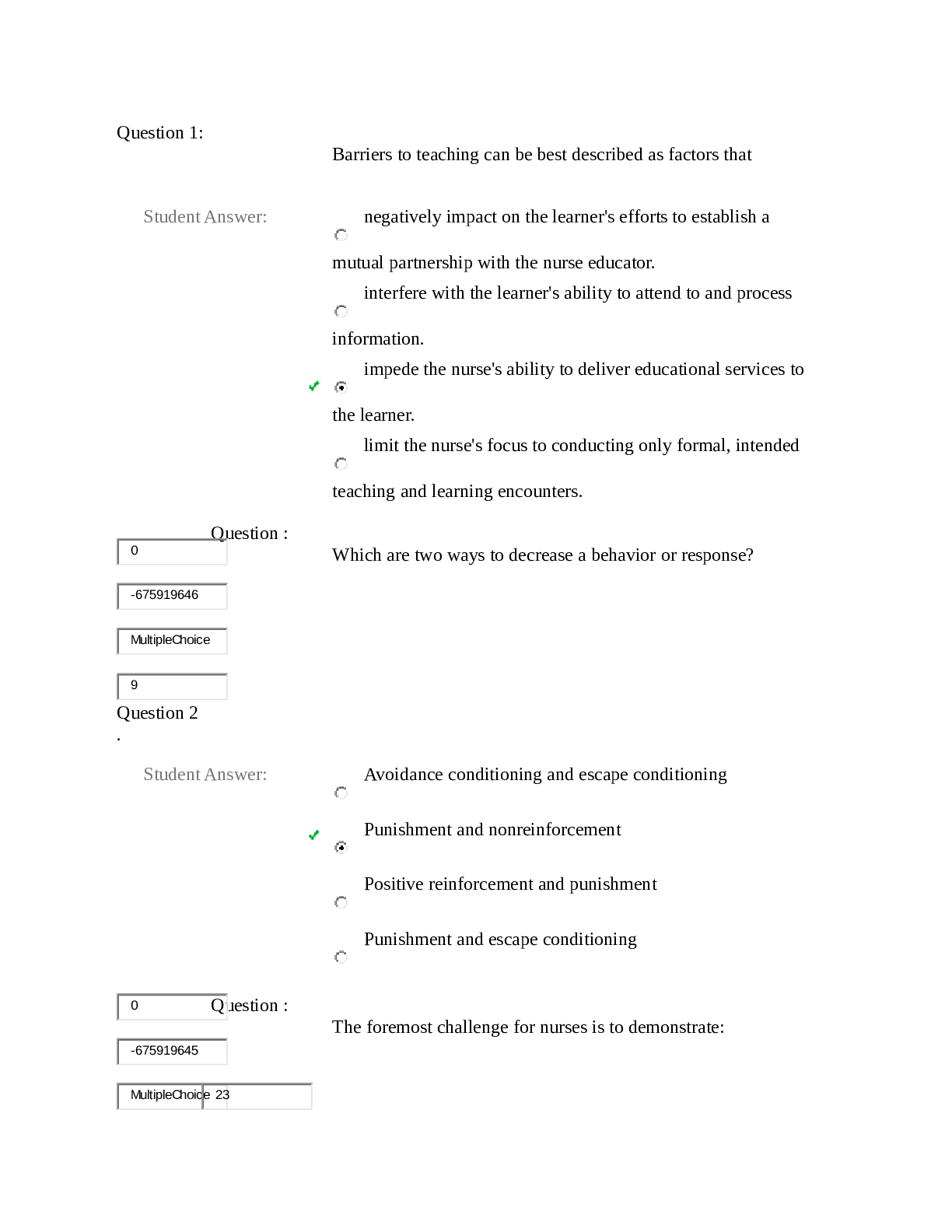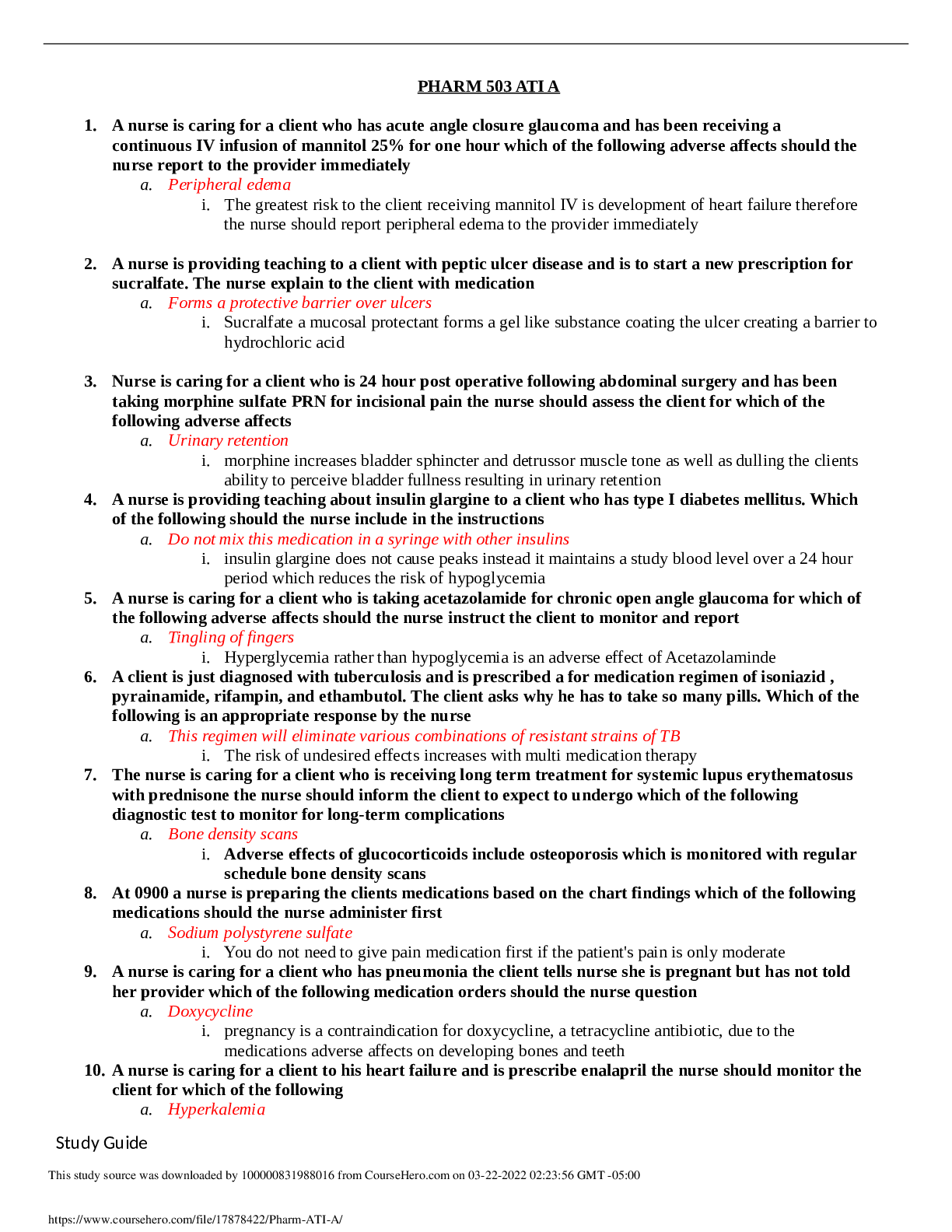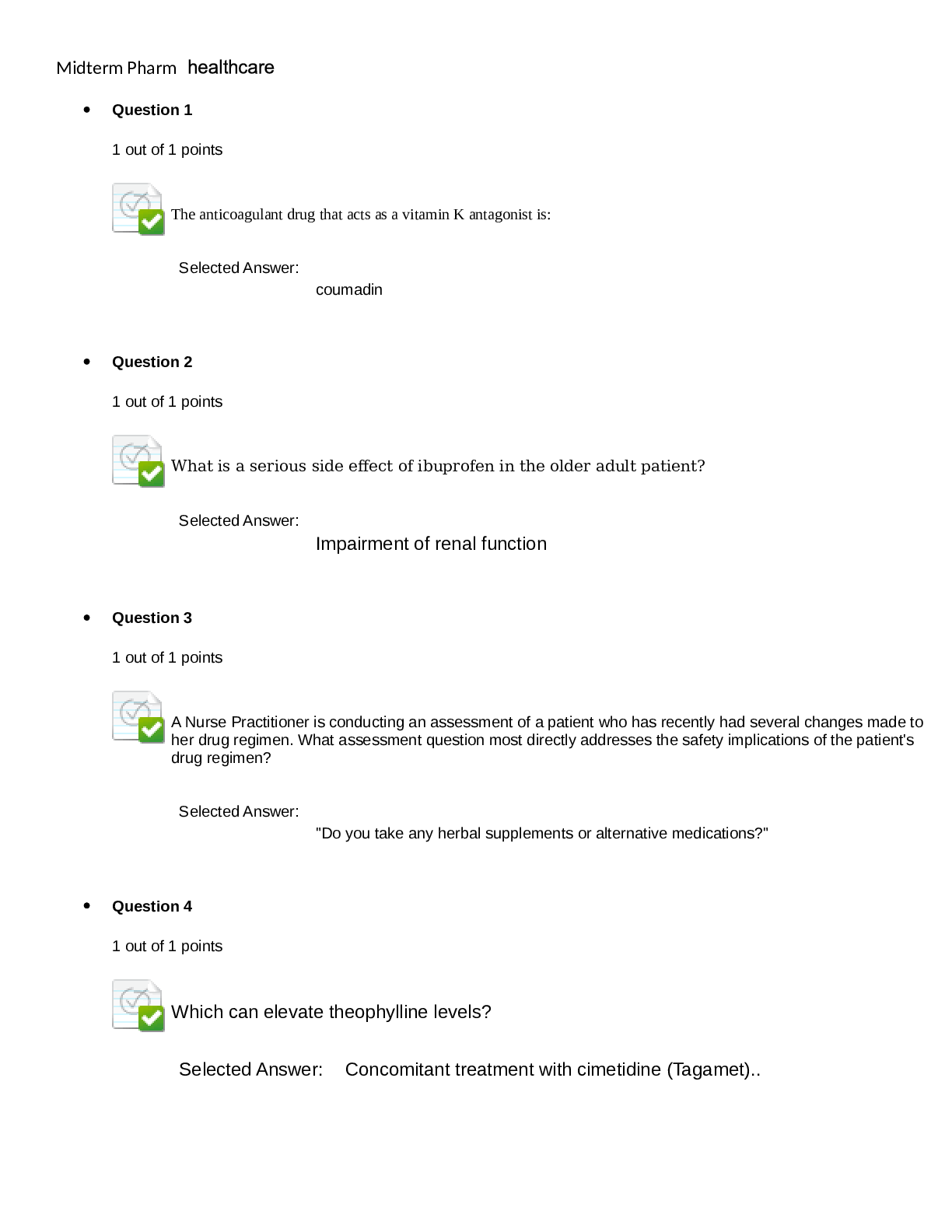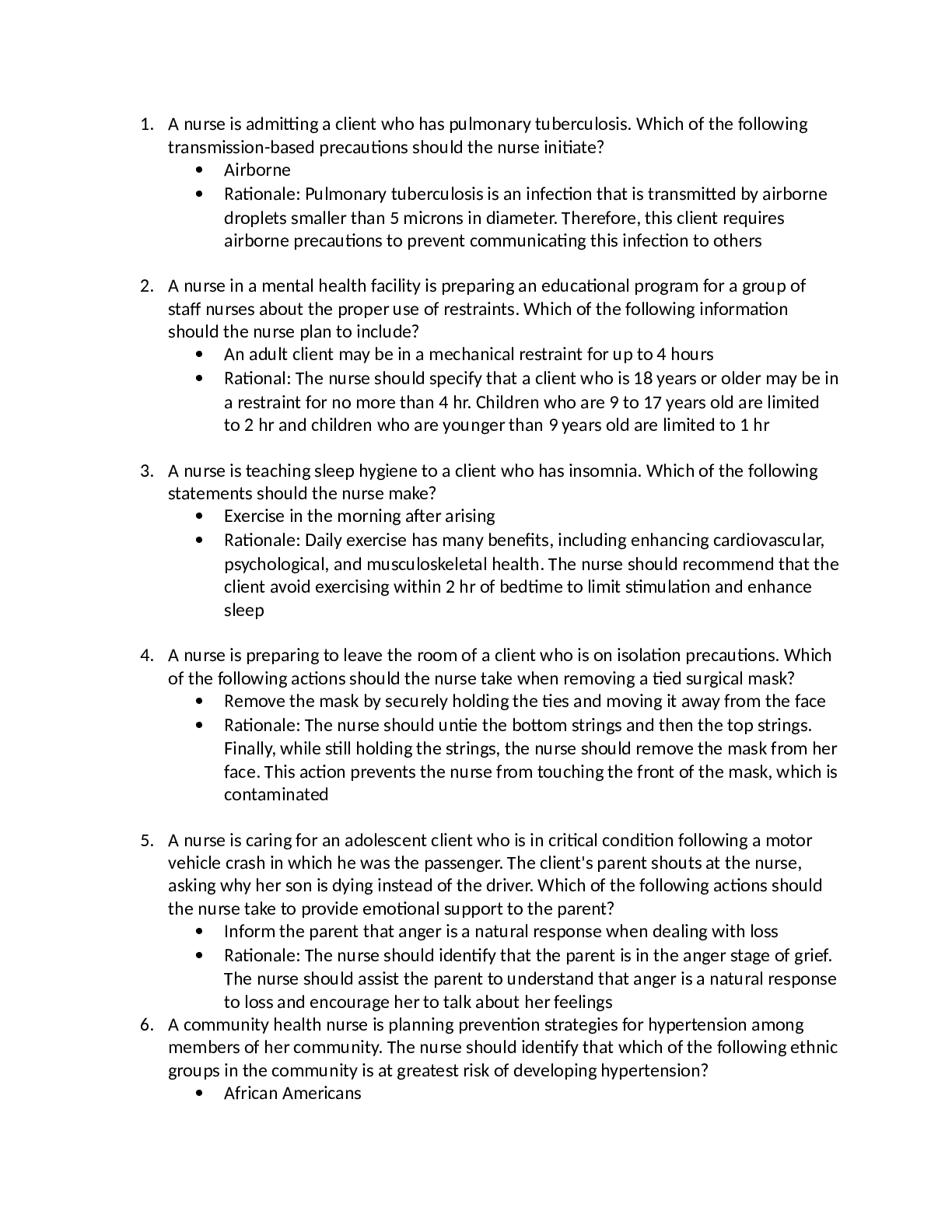Human Resource Management > QUESTIONS & ANSWERS > SHRM-CP Terms Latest Updated 2022 Already Passed. Rated A (All)
SHRM-CP Terms Latest Updated 2022 Already Passed. Rated A
Document Content and Description Below
SHRM-CP Terms Latest Updated 2022 Already Passed ADA Amendments Act (ADAAA) ✔✔Amendments to Americans with Disabilities Act covering the definition of individuals regarded as having a disabilit... y, mitigating measures, and other rules of construction to guide the analysis of what constitutes a disability. ADDIE model ✔✔Five-step instructional design process that governs the development of learning programs. Adverse impact ✔✔Type of discrimination that results when a neutral policy has a discriminatory effect; also known as disparate impact. Age Discrimination in Employment Act (ADEA) ✔✔Act that prohibits discrimination in employment for persons age 40 and over. Alternative dispute resolution (ADR) ✔✔Umbrella term used to describe a number of problemsolving and grievance resolution approaches. Americans with Disabilities Act (ADA) ✔✔Act that prohibits discrimination against a qualified individual with a disability because of his/her disability. Analytics ✔✔Tools that convert metrics to be used for decision support by adding context or further subclassifying comparison groups. Andragogy ✔✔Study of how adults learn. Applicant tracking software (ATS) ✔✔Software that provides an automated way for organizations to manage the recruiting process.Apprenticeship ✔✔Relates to technical skills training; often a partnership between employers and unions. Arbitration ✔✔Procedure in which disputes are submitted to one or more impartial persons for final determination. Assessment centers ✔✔Assessment tools that provide candidates a wide range of leadership situations and problem-solving exercises. Assignees ✔✔Employees who work outside their home countries. At-will employment ✔✔Common-law principle stating that employers have the right to hire, fire, demote, and promote whomever they choose for any reason unless there is a law or contract to the contrary and employees have the right to quit a job at any time. Auditory learners ✔✔People who learn best by relying on their sense of hearing. Balanced scorecard ✔✔Measurement approach that provides an overall picture of an organization's performance as measured against goals in finance, customers, internal business processes, and learning and growth. Balance sheet ✔✔Statement that reports the financial position of the organization at a specific point in time; shows assets, liabilities, and shareholder equity. Behavioral interview ✔✔Type of interview that focuses on how applicants previously handled real situations. Benchmarking ✔✔Process that compares performance levels and/or processes of one entity with those of another to identify performance gaps and set goals aimed at improving performance.Benefits ✔✔Payments or services provided to employees to cover issues such as retirement, health coverage, sick pay/disability schemes, life insurance, and paid time off. Bias ✔✔Occurs when an appraiser's values, beliefs, or prejudices distort performance ratings. Big data ✔✔High-volume, high-velocity, and high-variety information assets that require innovative forms of information processing for enhanced insight and decision making. Blended learning ✔✔Planned approach to learning that includes a combination of instructor-led training, self-directed study, and/or on-the-job training. Blogs ✔✔Broadcast-style communications that enable authors to publish articles, opinions, product or service reviews, etc., on a web page. Blue ocean strategies ✔✔Strategies that create competitive advantage by creating a new marketplace arena in which there are no other competitors. Bona fide occupational qualification (BFOQ) ✔✔Situation in which religion, sex, or national origin is reasonably necessary to carrying out a particular job function in the normal operations of an organization. Brain drain ✔✔Exit of educated and skilled citizens from emerging and developing countries for better-paying jobs in developed countries. Broadbanding ✔✔Combining several salary grades or job classifications with narrow pay ranges into one band with a wider salary spread. Burlington Industries, Inc. v. Ellerth ✔✔Court ruling that distinguished between supervisor harassment that results in tangible employment action and supervisor harassment that does not.Business Acumen ✔✔The ability to understand and apply information with which to contribute to the organization's strategic plan. Business case ✔✔Presentation to management that establishes that a specific problem exists and argues that the proposed solution is the best way to solve the problem in terms of time, cost efficiency, and probability of success. Business intelligence ✔✔Ability to gather and analyze data from inside and outside the organization so that information is available for decision makers. Career development ✔✔Process by which employees progress through a series of stages in their careers, each of which is characterized by relatively unique issues, themes, and tasks. Career management ✔✔Preparing, implementing, and monitoring employees' career paths, with a primary focus on the goals and needs of the organization. Career planning ✔✔Actions and activities that individuals perform in order to give direction to their work lives. Cash flows statement ✔✔Statement that shows incoming and outgoing cash in the areas of operations, investments, and financing and remaining cash reserves; reflects an organization's ability to meet its current and short-term obligations. Cause-and-effect diagram ✔✔Diagram that maps out a list of factors that are thought to affect a problem or a desired outcome. Center of excellence (COE) ✔✔HR structural alternative established as an independent department that provides services within a focused area to internal clients.Central tendency error ✔✔Error that occurs when an appraiser rates all employees within a narrow range, regardless of differences in actual performance. Chain of command ✔✔Line of authority within an organization. Check sheets ✔✔Simple visual tools used to collect and analyze data. Civil law ✔✔Legal system based on written codes (laws, rules, or regulations). Civil Rights Act of 1964 ✔✔First comprehensive U.S. law making it illegal to discriminate on the basis of race, color, religion, sex, or national origin. Civil Rights Act of 1991 ✔✔Act that expands the possible damage awards available to victims of intentional discrimination to include compensatory and punitive damages; gives plaintiffs in cases of alleged discrimination the right to a jury trial. Cloud computing ✔✔Style of computing in which scalable IT-enabled capabilities are delivered as a service using Internet technologies. Code of conduct ✔✔Principles of conduct within an organization that guide decision making and behavior; also known as code of ethics. Codetermination ✔✔Form of corporate governance that requires a typical management board and a supervisory board and that allows management and employees to participate in strategic decision making. Collective bargaining ✔✔Process by which management and union representatives negotiate the employment conditions for a particular bargaining unit for a designated period of time.Collective bargaining agreement ✔✔Agreement or contract negotiated through collective bargaining process. Common law ✔✔Legal system in which each case is considered in terms of how it relates to legal decisions that have already been made; evolves through judicial decisions over time. Communication ✔✔The ability to effectively exchange information with stakeholders. Comparable worth ✔✔Concept that states that jobs requiring comparable skills, effort, responsibility, and working conditions filled primarily by women should have the same job classification and salary as similar jobs filled by men. Compa-ratio ✔✔Pay rate divided by the midpoint of the pay range. Compensation ✔✔All financial returns (beyond any benefits payments or services), including salary and allowances. Competencies ✔✔Clusters of highly interrelated attributes, including knowledge, skills, and abilities (KSAs) that give rise to the behaviors needed to perform a given job effectively. Competency-based interview ✔✔Type of interview in which interviewer asks questions related to competencies for the position and asks candidates to provide examples of times they demonstrated the competencies. Compliance program ✔✔System for ensuring that policies and procedures addressing issues identified in the code of conduct are presented to and understood and acted on by everyone in the organization and for evaluating the results of those efforts. Conciliation ✔✔Method of nonbinding dispute resolution involving a third party who tries to help disputing parties reach a mutually agreeable decision; also known as mediation.Conflict of interest ✔✔Situation in which a person or organization has the potential to be influenced by two opposing sets of incentives. Consolidated Omnibus Budget Reconciliation Act (COBRA) ✔✔Act that provides individuals and dependents who may lose medical coverage with opportunity to pay to continue coverage. Constructive discipline ✔✔Form of corrective discipline that implements increasingly severe penalties for employees; also called progressive discipline. Consultation ✔✔The ability to provide guidance to organizational stakeholders. Contingency plan ✔✔Protocol that an organization implements to respond to an unplanned but identified risk event. Contrast effect ✔✔Error that occurs when strong candidates who interview after weak ones appear even more qualified than they actually are because of the contrast. Contrast error ✔✔Error that occurs when an employee's rating is based on how his or her performance compares to that of another employee rather than objective standards. Control chart ✔✔Chart that illustrates variations from normal in a situation over time. Core competencies ✔✔Skills, knowledge, and abilities that employees must possess in order to successfully perform job functions that are essential to business operations. Corporate social responsibility (CSR) ✔✔Recognition of the impact a corporation has on the lives of its stakeholders (including shareholders, employees, communities, customers, and suppliers) and the environment; can include corporate governance, corporate philanthropy, sustainability, and employee rights and workplace safety.Cosourcing ✔✔Arrangement in which an enterprise and a vendor share different tasks within a larger complex, often strategic responsibility. Cost-benefit analysis ✔✔Ratio of value created to cost of creating that value; allows management to determine the financial impact particular activities and programs have on an organization's profitability. Cost-of-living adjustment (COLA) ✔✔Periodic compensation payment given to eligible employees regardless of their performance or organizational profitability; usually linked to inflation. Critical evaluation ✔✔The ability to interpret information with which to make business decisions and recommendations. Critical path ✔✔Describes the shortest amount of time required to complete a project, taking into account all project task relationships—for example, whether task C must be completed before Task E, and whether Tasks A and B can be completed at the same time. Cultural noise ✔✔Failure to recognize responses of a candidate that are socially acceptable rather than factual. Cultural relativism ✔✔Concept that argues that ethical behavior is determined by local culture, laws, and business practices. Culture ✔✔Set of beliefs, attitudes, values, and behaviors shared by members of a group and passed down from one generation to the next. Dashboards ✔✔Reporting mechanisms that aggregate and display metrics and key performance indicators (KPIs).Database ✔✔Data structure that stores organized information (numeric information as well as sound clips, pictures, and videos). Database management system (DBMS) ✔✔Variety of software applications that electronically manage stored data. Dedicated HR ✔✔HR structural alternative that allows businesses with different strategies in multiple units to apply HR expertise to each unit's specific strategic needs. Delphi technique ✔✔Forecasting technique that progressively collects information from a group without physically assembling the contributors. Departmentalization ✔✔Way an organization groups jobs to coordinate work. Developmental activities ✔✔Activities that focus on preparing employees for future responsibilities while increasing their capacity to perform their current jobs. Differential pay ✔✔Pay rates that are affected by where or when an employee works. Dilemma reconciliation ✔✔Process of charting a course through cultural differences. Disability ✔✔Physical or mental impairment that substantially limits major life activities. Disparate impact ✔✔Type of discrimination that results when a neutral policy has a discriminatory effect; also known as adverse impact. Disparate treatment ✔✔Type of discrimination that occurs when an applicant or employee is treated differently because of his or her membership in a protected class.Distance learning ✔✔Process of delivering educational or instructional programs to locations away from a classroom or site. Diversity ✔✔Differences in characteristics of people; can involve personality, work style, race, age, ethnicity, gender, religion, education, functional level at work, etc. Diversity council ✔✔Task force created to define a diversity and inclusion initiative and guide the development and implementation process. Diversity dimensions ✔✔Framework for understanding the range and complexity of diversity; includes four layers (personality, internal dimensions, external dimensions, and organizational dimensions); also known as identity group. Diversity of thought ✔✔Concept describing the presence of different types of cognitive processes in a workplace; opposed to "groupthink", or similarity of thought processes and opinions. Divestiture ✔✔Sale by a company of an asset that is not performing well, that is not core to the company's business, or that is worth more as a separate entity. Domestic partners ✔✔Unmarried couples, of the same or opposite sex, who live together and seek economic and noneconomic benefits comparable to those granted to their married counterparts. Drug-Free Workplace Act ✔✔Requires federal contractors with contracts of $100,000 or more as well as recipients of grants from federal government to certify they are maintaining a drug-free workp [Show More]
Last updated: 2 years ago
Preview 1 out of 38 pages
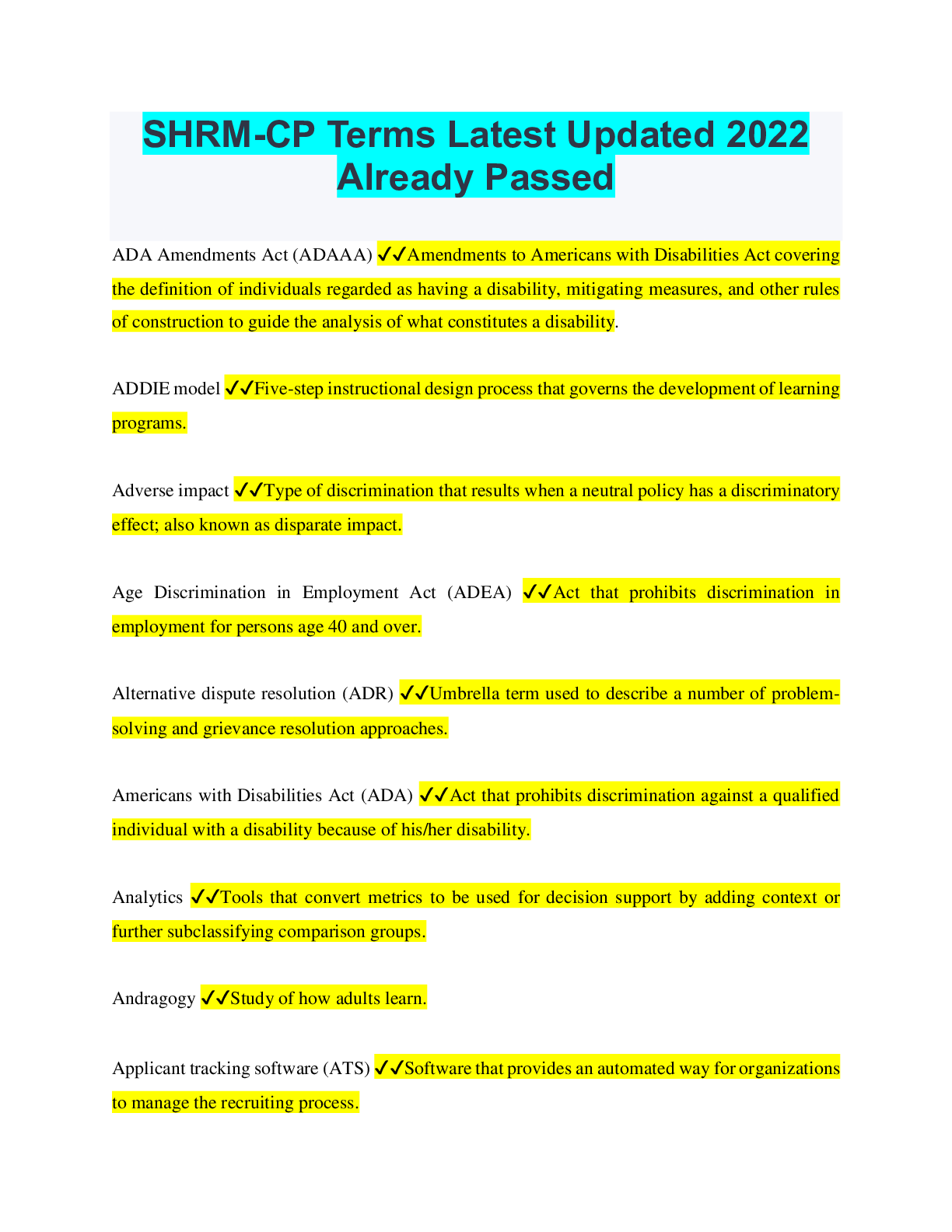
Buy this document to get the full access instantly
Instant Download Access after purchase
Buy NowInstant download
We Accept:

Also available in bundle (1)

THE SHRM BUNDLE. DIFFERENT VERSIONS OF QUESTIONS WITH ANSWERS. 100% COMPREHENSIVE. LATEST PREDICTOR PAPERS. RATED A
ALL YOU NEED TO PASS THE SHRM EXAMS. DIFFERENT VERSIONS. DOWNLOAD FOR EASY REVISION.
By bundleHub Solution guider 2 years ago
$26
19
Reviews( 0 )
$8.00
Can't find what you want? Try our AI powered Search
Document information
Connected school, study & course
About the document
Uploaded On
Sep 30, 2022
Number of pages
38
Written in
Seller

Reviews Received
Additional information
This document has been written for:
Uploaded
Sep 30, 2022
Downloads
0
Views
171












